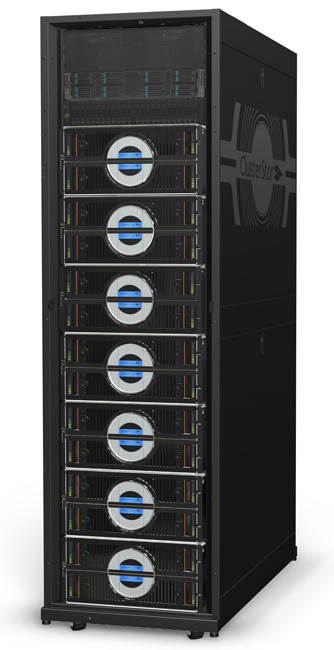Seagate has announced several new HPC storage solutions to address the growing need of high-performance computing applications. The Seagate ClusterStor G200 Spectrum Scale is a high performance computing storage solution, designed to help data-driven enterprises manage massive storage growth. The ClusterStor A200 is the first tiered archive storage system for high performance computing, designed to help reduce storage and operational costs by up to 50 percent compared to tier-one storage platforms. And the ClusterStor L300, is Seagate's newest and highest performing version of its ClusterStor Lustre storage architecture.
Seagate has announced several new HPC storage solutions to address the growing need of high-performance computing applications. The Seagate ClusterStor G200 Spectrum Scale is a high performance computing storage solution, designed to help data-driven enterprises manage massive storage growth. The ClusterStor A200 is the first tiered archive storage system for high performance computing, designed to help reduce storage and operational costs by up to 50 percent compared to tier-one storage platforms. And the ClusterStor L300, is Seagate's newest and highest performing version of its ClusterStor Lustre storage architecture.

The ClusterStor G200 is shipped pre-configured, tested, and ready to deploy out of the box, allowing businesses to have it up and running within hours. Seagate also indicates that users benefit from ClusterStor’s reduced footprint when compared to traditional external file-serving nodes. As a result, this will aid in power efficiency, cooling, and administrative costs without conceding performance. Additionally, ClusterStor for IBM Spectrum Scale leverages Grid RAID, which is Seagate’s declustered RAID feature that helps improve rebuild times by 400 percent compared to legacy RAID systems.
The A200 is designed to complement the rest of Seagate’s ClusterStor family of scale-out storage systems, focusing on the non-disruptive migration of designated data off of the performance-optimized, primary storage tiers. It does this while keeping it online for fast retrieval. As a result, Seagate asserts that this will help avoid forcing businesses to choose between having all of the data available to make the best analysis versus the time required to retrieve data from tape. The pre-configured ClusterStor A200 solution also includes an automatic policy-driven hierarchical storage management (HSM) system as well as near limitless scale-out capacity.
The A200 is compatible with up to seven scalable storage units per rack. Additionally storage units and racks can be added to the storage pool as well as a highly available ClusterStor management unit. The A200 system also leverages 3rd generation ClusterStor erasure coding for data and disaster protection with up to 11 nines of durability. The erasure code is network-based, which enable the resources of the entire system for fast rebuilds of failed drives. It also helps to improve availability while maximizing the amount of useable storage. To complement the already durable solution, Seagate indicates that the ClusterStor erasure code uses a unique mechanism that prioritizes the most critical data elements needed to rebuild. This significantly improves the time required to return the system to the highest data protection.
The L300 is quoted to boast upwards of 112GB/s in throughput per rack when integrated with Seagate’s ClusterStor HPC drives, which is a performance improvement of 77% over previous ClusterStor systems. This impressive performance will help customers reduce data center space, power and cooling costs as well as simplifying management and equipment requirements. The L300 also is designed to optimize random and sequential I/O workloads across the entire storage cluster, which will improve workflow productivity.
The ClusterStor L300 features an ‘extreme mode’ that allows it to quoted over 448GB/s in performance per rack as well as superior small file performance. This configuration leverages Seagate’s latest Flash Memory technology with the ClusterStor L300 integrated storage solution, which allows it to boast high productivity for applications that require ultimate performance in quality of service for their demanding workload requirements. In addition, the ClusterStor L300 also supports the use of Seagate’s Solid State Hybrid Drives, which offers a value-oriented option for transparent small file performance acceleration.
The ClusterStor L300 Lustre solution supports Object Storage Target disk pool management. This allows for the creation of discrete storage pools for each type of media from Flash Memory, ClusterStor HPC Drives, SSHDs, and Capacity Drives as disk pools within the same file system and enables application consolidation within a single storage. The L300 also supports next-generation networks built for Exascale computing, such as Intel’s Omni-Path and the Mellanox EDR 100Gb/s Infiniband.
Seagate ClusterStor Parallel Storage System
Sign up for the StorageReview newsletter
